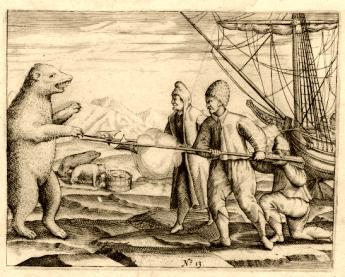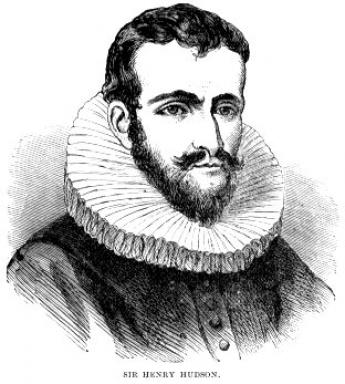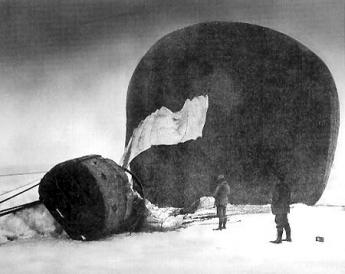Tip Verband Deutscher Antiquare e.V.
Collecting Rare Books and First Editions: Chilling Tales from the Icy Wastes

By Frank Werner
The polar regions have always had a huge attraction for mankind and its explorers. What lay in or beyond those icy wastes? An open sea? The way to Asia? Riches beyond the dreams of avarice? Many set out to find out, never to return. Probably no other field of exploration has brought forth so many heroes, sung and unsung, so much suffering and so many, often unnecessary, deaths. Probably most of the gruesome deaths in the icy reaches will never be known or told, but several made it into print from the 16th to the 20th century. I have picked 10 expeditions at random, my only criterion being that there had to be horrible suffering, death, and, maybe, cannibalism.
Sir Hugh Willoughby
of Derbyshire (died 1554) was an early English Arctic voyager. He was sent out in 1553, as captain of the Bona Esperanza with two other vessels under his command, by a company of London merchants known as the Company of Merchant Adventurers to New Lands, which later became the Muscovy Company. The vessels were separated by "terrible whirlwinds" in the Norwegian Sea. On 14 September 1553 Willoughby sailed into a bay near the present border between Finland and Russia. The ships with the frozen crews, including Captain Willoughby and his journal, were found by Russian fishermen a year later. It has been suggested that Sir Hugh Willoughby and his crew were killed by carbon monoxide poisoning, following their decision to insulate their ship from the bitter Arctic cold. A 19th century woodcut shows him and his crew sitting dispiritedly on deck.
The ill-fated voyage is described in Hakluyt’s Principal Navigations. Next in line is
Willem Barentsz
(anglicized as William Barents or Barentz) (c. 1550 – 20 June 1597) was a Dutch navigator, cartographer, explorer, and the leader of several early expeditions to the far north. The Barents Sea, Barentsburg and the Barents Regions were named after him.
His career as an explorer was spent searching for the Northeast Passage which he reasoned must exist as clear, open water north of Siberia since the sun shone 24 hours a day, which he believed would have melted any potential ice. His first two expeditions, having set out with great hopes, both returned due to unfavourable ice conditions. In 1596 he set out again, hoping to win the high reward offered to anyone who successfully navigated the Northeast Passage. He commanded two ships, but they split up due to a disagreement on the course.
Barentz’ ship was trapped in the ice near Novaya Zemlya and the 16-man crew was forced to spend the winter on the ice. They dismantled their ship to build a lodge which the called “Het Behouden Huys”. They soon realized that their socks would burn before their feet got warm and took to heating stones and cannon balls to warm their beds. They even transformed a large barrel into a steam-bath. Fortunately, the dismantled ship bore salted beef, butter, cheese, bread, barley, peas, beans, flour, oil, vinegar, mustard, salt, beer, wine, brandy, smoked bacon, ham and fish. Much of the beer froze, bursting the casks, which must have been a bitter blow to any right-thinking Dutch sailor! Gerrit de Veer, the ships carpenter who kept a diary, reported a shortage of beer and bread, with wine being rationed four days later. They nearly suffocated when someone had the bright idea of keeping the warmth in the house by blocking the chimney. When the ice did not melt next summer, the crew, now ridden by scurvy, and with a very sick captain, built two small boats, and dragged them to the open water. Barentz died of malnutrition after 7 days in one of the boats. Eventually, only 12 crewmen were rescued by a Russian merchant vessel, and eventually found their way home again.
Gerrit de Veer later published his diary, which was eagerly read and translated into German, English and French. Another captain who met his end at sea was
Henry Hudson
(c. 1560/70s – 1611?). He was an English sea explorer and navigator in the early 17th century. After several voyages on behalf of English merchants to explore a prospective Northeast Passage to India, Hudson explored the region around what is today New York, while looking for a western route to Asia under the auspices of the Dutch East India Company. He explored the river which eventually was named for him and laid thereby the foundation for the Dutch colonization of the region.
Hudson made several voyages for the Dutch East India Company, searching for a shortcut to India, either around Russia, the Northeast Passage, or through a strait believed to be in Northern America, the North West passage. He started on his final voyage in 1610, this time under the English flag. He rounded Greenland and excitement was high due to the expectation that the ship had finally found the Northwest Passage through the continent. In August they entered what is now Hudson Bay, and mapped the area, without, of course, finding the passage. They were trapped by ice, and had to winter there.
When the ice cleared in the spring of 1611, Hudson planned to continue his explorations, but the crew was fed up and wanted to go home. Most of the crew mutinied in June. Descriptions of the successful mutiny are one-sided, because the only survivors who could tell their story were the mutineers and those who went along with the mutiny. Allegedly in the latter class was ship's navigator Abacuk Pricket, a survivor who kept a journal that was to become a key source for the narrative of the mutiny. According to Pricket, the leaders of the mutiny were Henry Greene and Robert Juet. Pricket's narrative tells how the mutineers set Hudson, his teenage son John, and six crewmen - men who were either sick and infirm or loyal to Hudson - adrift from the Discovery in a small shallop, an open boat, effectively marooning them in Hudson Bay. The Pricket journal reports that the mutineers provided the castaways with clothing, powder and shot, some pikes, an iron pot, some meal, and other miscellaneous items. They were never herd of again. John Collier’s painting depicts the melancholy scene, with the father sitting in the stern of the boat, his son at his feet.
Upon their return, the crew placed the blame for the mutiny on two seamen, who had conveniently died during the return trip. The surviving 8 seamen were acquitted of the charge of murder, probably because their knowledge of sailing routes and conditions was too valuable to waste. So, another explorer, this time with his own son and several loyal companions, became a victim of the ice.
John Franklin’s
(1786-1847) fate is to well known for me to put it down here in detail. He and his crew were another victim of the search for the Northwest Passage in the Canadian Arctic. When he was given command of this expedition in 1845, he was already 59 years old, very experienced in Arctic travel, but, by the standards of his time, an old man. He commanded the ships Erebus and Terror. Both ships were fitted out with steam engines that enabled them to make 4 knots under their own power when there was not enough wind to sail by. They also powered a steam-based heating and distillation system.
It is now believed that the expedition wintered in 1845-46 on Beechey Island. Terror and Erebus became trapped in ice off King Williams Island and never sailed again. According to a note found on that island, Franklin died there in 11 June 1847.
After two years and no word from the expedition, Lady Franklin urged the Admirality to send a search party, the first of many. A reward of ? 20,000 was offered for finding the expedition. Eventually, more men and ships were lost looking for Franklin than in the expedition itself. The Scottish explorer Dr. John Rae discovered the true fate of the Franklin party from talking to Inuit hunters. He was told that both ships became icebound, the men had tried to reach safety on foot but had succumbed to cold. Rae published his account of “The Melancholy Fate of Sir John Franklin and His Party, as Disclosed in Dr. Rae’s Report Together with the Despatches and Letters of Captain M’Clure, and Other Officers Employed in the Arctic Expeditions …” in London in 1854.
In 1997, more than 140 years after Dr. Rae’s report, his account was finally vindicated; blade cut marks on the bones of some of the crew found on King William Island strongly suggested that conditions had become so dire that some crew members resorted to cannibalism. It appeared from these studies that a combination of bad weather, years locked in ice, disease including scurvy, poisoned food, botulism and starvation had killed everyone in the Franklin party. A classic case of sheer, enormous bad luck. Another man who’s luck (nearly) ran out was
Adolphus Greely
(1844-1935). He is best remembered as the commander of the Lady Franklin Bay Expedition during America’s first International Polar Year, a successful scientific expedition gone fatefully wrong.
Early in the expedition, several important discoveries and a number of sledge journeys were made. Most importantly, the scientific observations were kept meticulously and carefully preserved. Things began to go wrong with the failure of two attempts to re-supply or relieve the base and its 25 men. In August 1883, after the relief failure, Greely ordered a retreat by boat, sledge and foot on the 500 mile trip south to Cape Sabine, where he hoped to find either a ship or a depot. They were terribly disappointed, as neither was there. They spent the long winter of 1883-1884 from September to June at Cape Sabine. 19 of the 25 men died, mainly from starvation and scurvy. They were reduced to eating their boots and leather belts, and a thin soup made from algae. One of the party, Charles Henry, was caught stealing food, and Greely ordered to execute him.
Even their eventual discovery nearly went wrong: Lying hopelessly in their ramshackle tent, they thought the steam whistle they herd was a hallucination and only at the very last moment one of them fired a shot that was heard aboard the vessel. It is hard to imagine a comparable set of miserable circumstances in any other polar story, although Franklin’s fate comes close. Greely’s account “Three Years of Arctic Service: An Account of the Lady Franklin Bay Expedition of 1881-84 and the Attainment of the Farthest North” was published in 1886.
Salomon August Andrée
(1854-1897) took to the air to win fame for his country, Sweden, and for himself. He perished while leading an attempt to reach the Geographical North Pole by hydrogen balloon.
Supported by the Royal Swedish Academy of Sciences and funded by celebrities like King Oscar II and Alfred Nobel, his polar exploration project was the subject of enormous interest and was seen as a brave and patriotic scheme. Andrée was very adept at raising money and interest in the scheme, and this may have led to its eventual downfall, in the true sense of the word.
The balloon Örnen was very well, even sumptuously equipped and carried not a few useless objects. These included quantities of Russian and US money in silver and gold, a white dress tie, an expensive porcelain bowl, the heavy silver base for a vase, a large collection of heavy towels, old newspapers and personal letters. More to the point, it also carried 36 doves, which were to bring back news of the balloon’s progress. But the balloon had a problem: It leaked, and Andrée and his companions knew it. And they also knew: In the face of the publicity and the expectations they had solicited, they could not turn back.
On July 11, 1897 the Örnen lifted off, loosing two guiding ropes right at the start. Soon they ran into foul weather, ice started to form on the balloon and forced it down on the pack ice. Andrée’s men packed all they could onto their sled and set out towards Svalbard. They reached land in early October after over two months on the ice, setting foot on Kvitoya, just east of Svalbard. Here they perished, probably within two weeks after landfall. It is assumed that they died of eating polar bear flesh carrying Trichinella parasites. The remains of the three men were found 30 years later by the Norwegian Bratvaag Expedition. A month later the ship Isbjorn made additional finds.
Andrée and his men had kept diaries to the very end. Note books, the diaries, photographic negatives and many utensils were recovered. The homecoming of the bodies of the three aviators was a grand event and they received a funeral with great honours. The account of the tragic journey taken from the adventurers’ diaries was translated into many languages (for example: Dem Pol entgegen. Auf Grund der während Andrées Polarexpedition 1897 geführten und 1930 auf Vitö gefundenen Tagebücher S.A. Andrées, N. Strindbergs und K. Fraenkels ... Brockhaus 1930; S. A. Andrée's Story : The Complete Record of His Polar Flight, 1897. From the Diaries and Journals of S. A. Andrée, Nils Strindberg, and K. Froenkel … New York 1930; Andrées polarærd 1897. Af S. A. Andrée, Nils Strindberg og Knut Frænkel. København 1930 ...)
Today, Andrée’s status as a national hero is being questioned. Several modern writers have speculated that he had become the prisoner of his own successful funding campaign and that he had been incapable of backing out or admitting weaknesses in the plans in front of the press. He is now seen as a manipulator of the national emotions of his age, bringing a meaningless death on himself and his two companions. Sic transit Gloria mundi!
To be continued ...
© Frank Werner (Brockhaus/Antiquarium)



